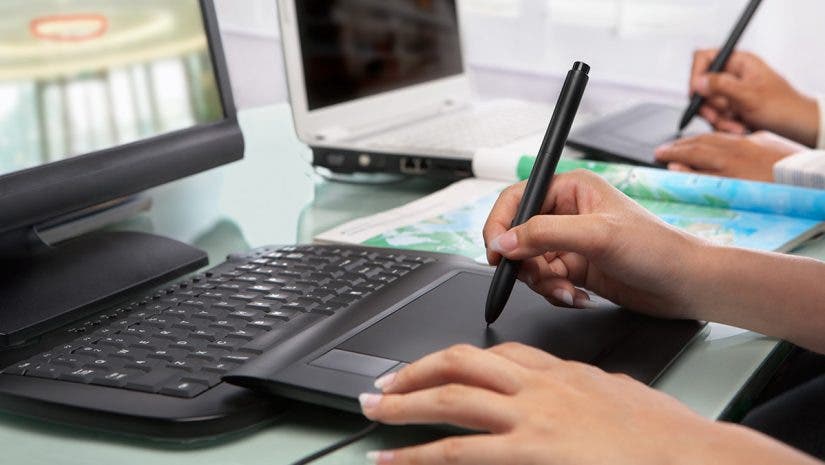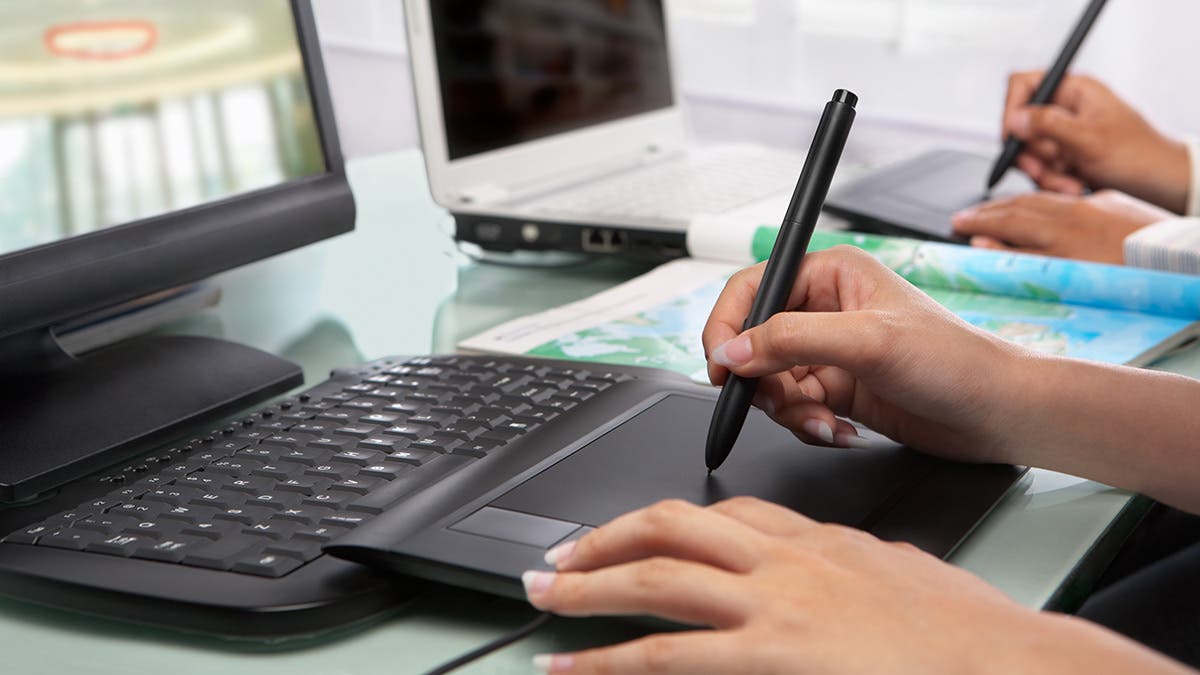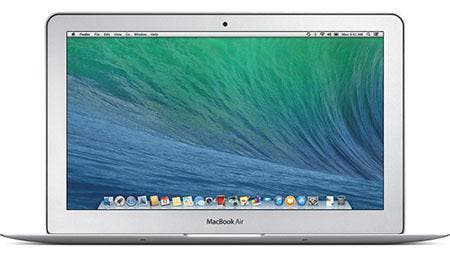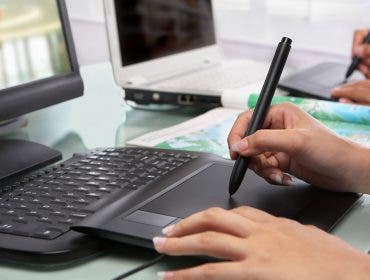Imagine being able to draw directly on your digital images to apply special effects or corrective brushes using a pen instead of scooting a mouse around your computer desk. Or being able to create works of art freehand–from scratch–with a stylus that applies more color when you press hard and less when you ease up.
That’s what Graphics Tablets are all about. Once the exclusive domain of professional graphic artists, they have become a mainstream tool for professional photographers and serious hobbyists because of their effectiveness, convenience and affordability.

Graphics tablets: Positives and Negatives
Positives
- Easier to hold
- Pressure controls intensity
- Valuable software package may be included
- May reduce chance of repetitive strain injury
- Must-have for graphics professionals
Negatives
- Takes up more desk space than mouse
- More expensive than a mouse
- Choices can be confusing (unless you read this article!)


A more mystical pooch: Variable stylus pressure made it easier to apply painterly effect in a controlled manner, creating a magical aura around this barnyard dog.
WHAT IS A GRAPHICS TABLET?
A graphics tablet consists of a smooth rectangular surface that is electronically divided into an invisible mathematical grid. Every point on the grid corresponds directly to a point in the image. The second component, a stylus, is used to draw or write on the tablet. As it slides over the surface it affects the points on the grid and consequently the points in the image. If the stylus is pressed down hard, the effect increases. (Some styli have a button or set of buttons that control writing pressure as well as other functions.) You can vary line thickness, transparency and opacity, and other effects simply by changing the pressure you use, giving your photos a more hand-made look.
Some professional graphics tablets allow you to draw on the actual image instead of a separate tablet. All graphics tablets have certain characteristics in common and can be compared by examining the specifications that define each characteristic. Let’s start with an understanding of what each means.
 HOW DO I FIND A GRAPHICS TABLET? HOW MUCH DO THEY COST?
HOW DO I FIND A GRAPHICS TABLET? HOW MUCH DO THEY COST?
Adorama carries dozens of graphics tablets in its Graphics Tablets Department, at prices ranging from around $55 for the VisTablet Mini Graphics Pen Tablet or Adesso CyberTablet Z7, both of which have small 3×5-inch working areas and are designed for beginners, to nearly $2,500 for the Wacom Cintiq 24HD interactive pen display tablet, which has a large touch scren interface. A typical mid-range model is the Adorama-priced $165 Wacom Bamboo Create Digital, right, with its 8.5×5.4-inch active area. If you are an enthusiast or even a pro starting out, expect to pay in the $150-300 range.
CHARACTERISTICS
First and foremost characteristic is size. The physical size is not as important as what’s known as the active area. The active area is the grid described above. Large grids allow more space between the active points. Smaller grids are easier to navigate because they require less hand movement, but deliver less precision. Think of it this way: if you were asked to draw a circle using only dots, you’d be able to make a smoother circle if you used more dots.
Common sizes for consumer-level graphics tablets are 4×5, 6×8, 9×12 and 12×18 inches. It’s important to note that these dimensions refer to the active area only–the physical footprint will in every case be larger. For example, a 4×5 tablet, like the one pictured here (A Wacom Graphire 4×5) has actual dimensions that may be closer to 8×10 inches. Professional tablets that feature on-screen drawing are naturally much larger. This will take up more room on your desk, but many graphics pro’s actually work with the tablet on their laps, as they might do when drawing!
Benefits: Graphics Tablet Size
- Bigger active area = finer control
- Smaller activer area = more desk space
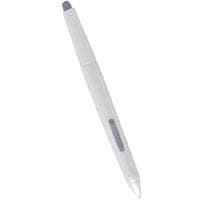 The next variable is stylus pressure sensitivity. This refers to the system’s sensitivity and response to pressure when the stylus (left) is pressed against the tablet surface. Pressure sensitivity lets you control brushes and other tools by varying the amount of pressure you apply via the stylus.
The next variable is stylus pressure sensitivity. This refers to the system’s sensitivity and response to pressure when the stylus (left) is pressed against the tablet surface. Pressure sensitivity lets you control brushes and other tools by varying the amount of pressure you apply via the stylus.
As you draw, you can control things like line thickness, brush size, opacity, color, and so forth. Think of it as a physical can of spray paint: press the applicator button lightly and only a little comes out; press hard and the flow increases. Most tablets have 512 or 1024 levels of control. Some have fewer. The more levels of sensitivity, the greater the control.
Benefits: Stylus Pressure Sensitivity
- Fine-control of line thickness, brush size, opacity
- fewer levels of control less expensive
- more levels of control more precise; best: 1024 levels
Another feature worth investigating: screen writing. Writing directly on the screen is the most natural and accurate way to edit an image. Some graphics tablets are actually touch-sensitive LCD monitors. They are more expensive, but some graphic artists couldn’t work without them. They enable increased productivity and for professionals, that makes them worthwhile. Cordless units allow the user to position the tablet on a desk, in their lap, or any other comfortable position. This type of tablet makes the most of the artist’s natural hand-eye coordination, and significantly reduces the potential for repetitive action fatigue.
Benefits: Screen writing
- Most natural way of editing image
- Increases productivity
- Makes hand-eye coordination easier
Also look at the number and type of function keys that are provided on the stylus. Function keys are programmable buttons that can replicate the effect of holding down the Alt or Ctrl key, produce mouse clicks, zoom, and deliver other keyboard shortcuts. Obviously, more keys means more functions can be programmed. Function keys are valuable because they improve productivity–your hand does not have to leave the stylus as often.
Benefits: Function Keys
- Another productivity booster
- Shortcuts to mouse clicks
- Programmable for frequently-used actions
BUNDLED ACCESSORIES
Does the tablet come with a mouse? Many do. A dedicated mouse improves functionality, particularly when working with other software like word processing or e-mail. Styli differ from model to model and brand to brand, too. Some are more comfortable than others. What you are looking for is comfort, control and versatility.
The last two characteristics to verify before you buy: bundled software and price. As you can imagine, tablets are available at many different price points. Check the software applications that are included in the package. In many cases, the value of the software significantly reduces the effective cost of the hardware, so take that into account when comparing units from different manufacturers. Some models are packaged with Adobe Photoshop Elements, for instance.
